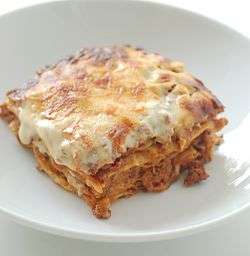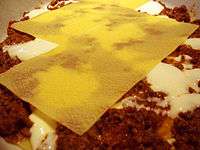Lasagne
|
Baked lasagne | |
| Type | Pasta |
|---|---|
| Course | Main |
| Place of origin | Italy |
| Region or state | Campania, Naples |
| Serving temperature | Hot |
| Main ingredients | Durum wheat |
| Variations | Lasagnette |
|
| |
Lasagne (/ləˈzænjə/ or /ləˈzɑːnjə/ or /ləˈsɑːnjə/, Italian pronunciation: [laˈzaɲɲe], singular lasagna) are wide, flat-shaped pasta, and possibly one of the oldest types of pasta.[1] The word "lasagne", and, in many non-Italian languages, the singular "lasagna", can also refer to a dish made with several layers of lasagne sheets alternated with sauces and various other ingredients.
Origins
Lasagne originated in Italy, traditionally ascribed to the city of Naples (Campania), where the first modern recipe was created in the Middle Ages and published in Liber de Coquina (The Book of Cookery), and became a traditional dish.[2] Traditional lasagne is made by interleaving layers of pasta with layers of sauce, made with ragù, bechamel, Parmigiano-Reggiano and chopped hard boiled eggs. In other regions and outside of Italy it is common to find lasagne made with ricotta or mozzarella cheese, tomato sauce, various meats (e.g., ground beef, pork or chicken), miscellaneous vegetables (e.g., spinach, zucchini, mushrooms) and typically flavored with wine, garlic, onion, and oregano. In all cases the lasagne are oven-baked.
Traditionally, pasta dough prepared in Southern Italy used semolina and water and in the northern regions, where semolina was not available, flour and eggs. Today in Italy, since the only type of wheat allowed for commercially sold pasta is durum wheat, commercial lasagne are made of semolina (from durum wheat).[3]
Emilia-Romagna's intensive farming economy in the northern region of Italy results in plentiful dairy and meat products, and their commonality in regional cooking – more so than the olive oil found in southern regions of Italy. Pastas from Emilia-Romagna and its capital, Bologna, are almost always served with a ragù, a thick sauce made from ingredients such as onions, carrots, finely ground pork and beef, celery, butter, and tomatoes.[4][5]
-
.jpg)
A close-up view of lasagne
Etymology
.jpg)
In Ancient Rome, there was a dish similar to the traditional lasagne one called lasana or lasanum (Latin word for "container", "pot") described in the book De re coquinaria by Marcus Gavius Apicius,[6] but the word could have a more ancient origin. The first theory is that lasagne comes from Greek λάγανον (laganon), a flat sheet of pasta dough cut into strips.[7][8][9][10] The word λαγάνα (lagana) is still used in Greek to mean a flat thin type of unleavened bread baked for the Clean Monday holiday.
Another theory is that the word lasagne comes from the Greek λάσανα (lasana) or λάσανον (lasanon) meaning "trivet or stand for a pot", "chamber pot".[11][12][13] The Romans borrowed the word as "lasanum", meaning "cooking pot" in Latin.[14] The Italians used the word to refer to the dish in which lasagne is made. Later the name of the food took on the name of the serving dish.
Another proposed link, or reference, is the 14th century dish "Loseyn"[15] as described in the British The Forme of Cury, a cookbook prepared by "the chief Master Cooks of King Richard II,"[16] which included English recipes as well as dishes influenced by Spanish, French, Italian, and Arab cuisines.[17] This recipe has similarities to modern lasagne in both its recipe, which features a layering of ingredients between pasta sheets, and its name. An important difference is the lack of tomatoes, which did not arrive in Europe until after Columbus reached America in 1492. The earliest discussion of the tomato in European literature appeared in a herbal written in 1544 by Pietro Andrea Mattioli[18] while the earliest discovered cookbook with tomato recipes was published in Naples in 1692, though the author had apparently obtained these recipes from Spanish sources.[18]
As with most other types of pasta, the Italian word is a plural form, lasagne meaning more than one sheet of lasagna, though in many other languages a derivative of the singular word "lasagna" is used for the popular dish. In English, lasagne (of whatever spelling) is usually used for the dish, and some redundantism like "lasagna noodles" can be used for just the pasta.
See also
- Baked ziti
- Casserole
- King Ranch Chicken – a casserole also known as "Texas Lasagna"
- List of Italian dishes
- Moussaka – a Mediterranean casserole that is layered in some recipes
- Pastelón – a baked, layered Puerto Rican dish made with plantains
- Pastitsio – a baked, layered Mediterranean pasta dish
- Timballo – an Italian casserole
References
- ↑ The Oxford Companion to Food 2nd Ed. Oxford University Press, USA. 2006. ISBN 0-19-280681-5.
- ↑ Liber de Coquina (1285), De lasanis. Gloning.
- ↑ "Presidential Decree 187" (PDF). translation from UA A.F.P.A. 9 February 2001. Retrieved 7 October 2012.
- ↑ Hess, Reinhardt and Salzer, Sabine. Regional Italian Cuisine. Barron's. Print.
- ↑ Root, Waverley. The Cooking of Italy. New York: Time-Life, 1968. Print.
- ↑ De re coquinaria. Apicio.
- ↑ λάγανον, Henry George Liddell, Robert Scott, A Greek-English Lexicon, on Perseus
- ↑ Andrew Dalby, "Food in the Ancient World from A to Z", Routledge, 2003, on Google books
- ↑ "Everyone Eats: Understanding Food and Culture", Eugene Newton Anderson, NYU Press, 2005
- ↑ The Real Italian Pasta
- ↑ λάσανα, Henry George Liddell, Robert Scott, A Greek-English Lexicon, on Perseus
- ↑ Muhlke, Christine (2 April 1997), "A Lighthearted Look at How Foods Got Their Names", Cookbook Shelf:Book Review, Salon.com, archived from the original on August 8, 2007, retrieved 30 September 2007
- ↑ "lasagna". Merriam-Webster's Online Dictionary. Encyclopædia Britannica Online. Retrieved 30 September 2007.
- ↑ lasanum, Charlton T. Lewis, Charles Short, A Latin Dictionary, on Perseus
- ↑ "Loseyns (Lozenges)". Celtnet. Dyfed Lloyd Evans. Archived from the original on 5 December 2012. Retrieved 24 March 2012.
- ↑ "Thys fourme of cury ys compyled of þe mayster cokes of kyng Richard þe secund ... by assent of Maysters of physik and of phylosophye".--"Things sweet to taste: selections from the Forme of Cury". 1996 ISBN 0-86373-134-1
- ↑ Bouchut, Marie Josèphe Moncorgé; Bailey, Ian (trans.); Hunt, Leah (trans.). "Oldcook : Forme of Cury and cookery books in English". Retrieved 24 August 2016.
- 1 2 Smith, Andrew F. (1994). The tomato in America: early history, culture, and cookery. Columbia, S.C, USA: University of South Carolina Press. ISBN 1-57003-000-6.

